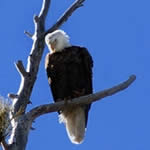
 On Saturday March 14th, the final bald eagle count of the winter was conducted by local Federal and State biologists and volunteers around lakes in the San Bernardino and San Jacinto Mountains. During beautiful weather conditions, large numbers of volunteers turned out for a chance to see one of our magnificent national birds. The effort was successful in tallying the bald eagles spending their winter vacations at local mountain lakes.
On Saturday March 14th, the final bald eagle count of the winter was conducted by local Federal and State biologists and volunteers around lakes in the San Bernardino and San Jacinto Mountains. During beautiful weather conditions, large numbers of volunteers turned out for a chance to see one of our magnificent national birds. The effort was successful in tallying the bald eagles spending their winter vacations at local mountain lakes.
A grand total of 12 eagles (8 adults, 4 juveniles) were observed in the four lake areas during the 1- hour count. 5 eagles (3 adults, 2 juveniles) were observed in the Big Bear/Baldwin Lake area; 3 eagles (2 adults, 1 juvenile) at Lake Arrowhead; 2 eagles (1 adult, 1 juvenile) at Silverwood Lake; and, 2 adult eagles at Lake Hemet. Juvenile eagles are distinguished by a brown head and tail; adults are recognized by the famous white head and tail – it takes 4-5 years to acquire full adult coloration. Juvenile eagles are the same size as the adults.
Approximately 180 volunteers participated in the 1-hour eagle census at four lakes (~80 at Big Bear area; 18 at Lake Arrowhead; 41 at Lake Hemet; and 38 at Silverwood Lake). The Forest Service and State Recreation Area biologists would like to thank the volunteers – it would not be possible to do this census without the help of the public!
The U.S. Forest Service and biologists have coordinated counts of this federally-protected species since 1978. Data from our local count will be added to the nation-wide Mid-Winter Bald Eagle census to assess recovery status of the species. We rely on volunteers to gather information during the monthly winter eagle counts. Counts are conducted for a 1-hour period from 9-10 a.m. Forest Service volunteers stationed around lakes in Big Bear, Arrowhead, and Idyllwild record all observations of bald eagles. Volunteers at Silverwood Lake State Recreation Area conduct simultaneous counts.
Bald eagles are similar to many southern Californians in that they visit the lakes of our San Bernardino and San Jacinto Mountains for their winter vacations between November and April. Instead of vacationing here for dynamite skiing, eagles come for the plentiful food supplies. As lakes and rivers up north freeze each winter, fish become unavailable under a thick layer of ice and ducks leave the frozen waters. The eagles’ “grocery stores” have essentially closed for the winter. So eagles fly south looking for open water stocked with food. The lakes of the San Bernardino and San Jacinto Mountains fit the bill perfectly–they are part of the Pacific Migratory Flyway, a migration freeway for millions of ducks. Eagles like to spend their winters here because of the abundant and tasty ducks and fish.
Our bald eagles normally migrate out of the San Bernardino and San Jacinto Mountains in late March, heading back to summer homes in Montana, Wyoming, Idaho, and Alberta, Canada. In recent years, a pair of bald eagles has remained at Lake Hemet and successfully produced several eaglets.
Catching a glimpse of our breath-taking national bird is relatively easy during the winter months. There are also some fantastic opportunities for excellent close-up photography. Just look in the tallest trees around the lakeshore. Or, if the lake is partially frozen, look for eagles perched on the ice near small groups of ducks using open water pockets. Remember that human presence may distract or disturb the eagles–so, try to limit your movements and don’t make loud noises when nearby. If possible, remain in your car while observing eagles–the car acts as a blind.
For More Information about Bald Eagle Counts
Big Bear Lake and Lake Arrowhead Contact:
Robin Eliason – reliason@fs.fed.us; 909-382-2832
Lake Hemet Contact: Heidi Hoggan hhoggan@fs.fed.us; 909-382-2945
Silverwood Lake State Recreation Area Contact: Kathy Williams – khwilliams@parks.ca.gov; 760-389-2303


